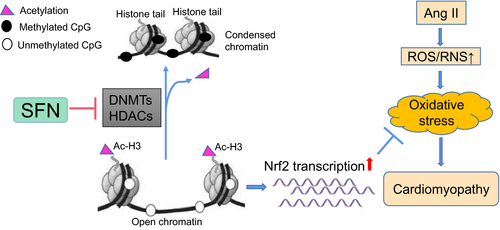This 2021 rodent study investigated mechanisms of sulforaphane’s persistent cardiac protection:
“Sulforaphane (SFN) reduced Ang II‐induced CpG hypermethylation and promoted Ac‐H3 [histone H3 acetylation] accumulation in the Nrf2 promoter region, accompanied by inhibition of global DNMT [DNA methyltransferase] and HDAC [histone deacetylase] activity, and a decreased protein expression of key DNMT and HDAC enzymes. Overall, DNA methylation and histone deacetylation are considered to inhibit gene transcription with a synergistic effect.

SFN reduces CpG methylation and promotes enrichment of Ac‐H3 in Nrf2 promoter by inhibiting DNMTs and HDACs. This partially contributes to long‐acting activation of cardiac Nrf2, thereby preventing Ang II‐induced cardiomyopathy.”
https://onlinelibrary.wiley.com/doi/10.1111/jcmm.16504 “Sulforaphane prevents angiotensin II‐induced cardiomyopathy by activation of Nrf2 through epigenetic modification”
This study used the same dose of sulforaphane as Broccoli sprouts activate the AMPK pathway, but stopped at six months (equivalent to a 34-year-old human) rather than continuing to eight months (a 42-year-old human):
“0.5 mg/kg SFN in mice is converted to a human dose of 0.0405 mg/kg. In some clinical studies, the dose of SFN used to treat chronic diseases is usually higher. The dose of SFN used in this study is relatively low and safe.”
Findings highlighted:
- A disease condition existed in young adults that wasn’t severe enough for them to experience overt symptoms; and
- A disease condition could be reversed or prevented when its causes were addressed before it became a problem.
Studies such as one mentioned in Part 2 of Eat broccoli sprouts for your eyes showed that if one waited until a disease condition became a problem, capabilities to adequately address causes and prevent it may be lost. Do you want to be limited to addressing a disease’s symptoms once it gets bad enough to be noticeable?
Both studies found positive effects of sulforaphane in preventing cardiomyopathy. The 2020 study demonstrated in myocardial cells that sulforaphane’s activation of the AMPK pathway – which is upstream of the Nrf2 pathway – activated Nrf2:
“NRF2-mediated antioxidative effects can be activated via AMPK/AKT/GSK3β pathway, developing another pathway to confront cardiac oxidative damage.”
The current study similarly stated:
“Nrf2 can also be regulated independently of Keap1. Evidence indicates that SFN may indirectly activate Nrf2 by affecting activity of several upstream kinases.”
Both studies’ “human dose of 0.0405 mg/kg” were a minuscule 2.8 mg (.0405 mg/kg x 70 kg) human dose compared with my estimated daily 52 mg of sulforaphane from eating 65.5 grams of microwaved 3-day-old broccoli sprouts twice daily. Yet that small amount of sulforaphane was able to prevent a daily dose of angiotensin II from causing conditions that would lead to heart disease.
I linked this study yesterday in Reversing osteoporosis with Nrf2 as an example of similarities with exercise and eating broccoli sprouts. While activating my Nrf2 pathways this morning by walking four miles at sunrise, I came across a heron who tolerated me getting close to them:

It ate breakfast off a branch, and pecked bugs from the water if they hopped off.